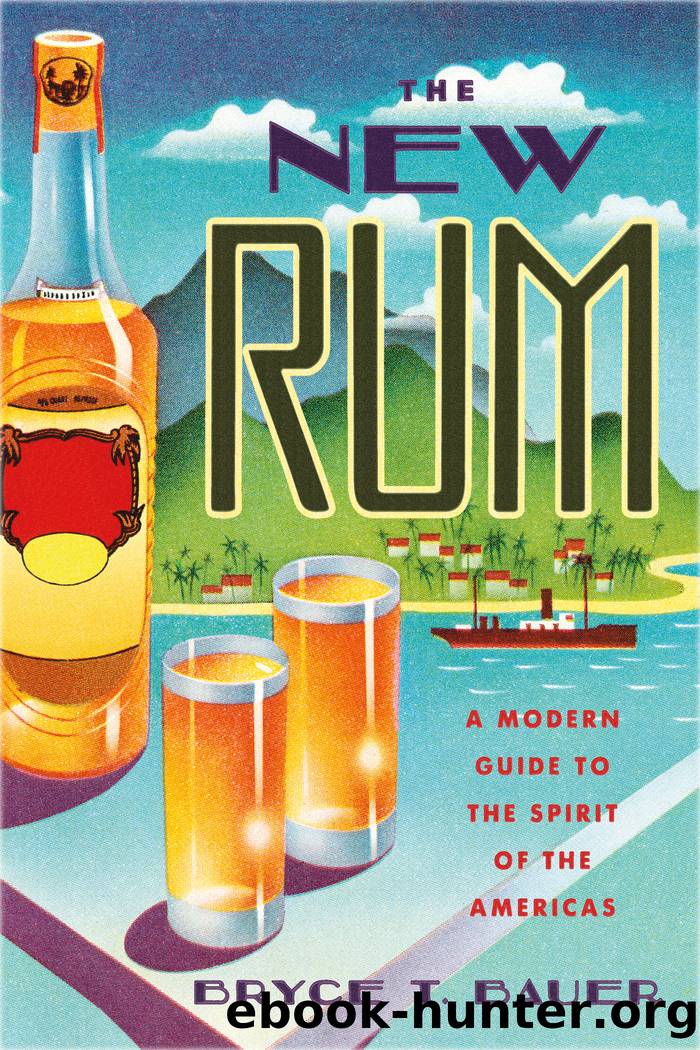The New Rum by Bryce T. Bauer

Author:Bryce T. Bauer
Language: eng
Format: epub
Publisher: Countryman Press
Published: 2018-05-22T00:00:00+00:00
While most of the cachaça produced in Brazil is made using massive multi-column stills and is considered low quality, connoisseur-worthy cachaça artesanal is produced in alambiques, or copper pot stills. Across the country, many cachaça alambiques look like these at the Novo Fogo (also known as Porto Morettes) cachaça distillery. The similarity is due to the fact that many of the stills are made by one of two companies in the country. The common pot still used to make cachaça looks radically different from that used to produce rum. In fact, it most resembles the type of brandy still often used to make cognac. All of the ones I saw were separated into three parts. The pot, where the fermented sugarcane wash was heated, was round, squat, and broad, like an alien saucer or a filled doughnut. Protruding from the center, where the alien’s lookout dome would be, or the hole if it was a doughnut that wasn’t laden with jelly, was a neck in the shape of a column, instead of the onion dome typical of cognac stills. From the top of that column a long, thin copper pipe shot out toward another copper pot of similar design to the first, but without a column.
This was a heat exchanger, I soon learned, the same as what is often found on cognac stills but usually absent from pot stills used for rum. Its purpose is to move some of the heat from the alcohol vapor coming out of the pot still and return it to the wash in the pot still—recovering, in essence, some of the energy needed to keep the distillation process going, rather than letting it dissipate.
From there, the vapor continued to a condenser, which could either be yet another pot-shaped apparatus or one that looked like a column. Cleverly, in all the cachaça stills I saw, the end of the coil, where the distillate comes out, was a pipe that smoothly turned back and forth in its fitting. Directly below was a bowl with a divider across the middle that was attached to a large, boxy, storage tank. Each side of the bowl drained into a different compartment in the tank, meaning that to make the head, heart, and tail cuts, all the distiller had to do was turn the pipe a few inches from one side of the bowl to the other. Many distilleries then take these heads and tails, further purify them, and use them for fuel for their vehicles or as solvents for cleaning.
Download
This site does not store any files on its server. We only index and link to content provided by other sites. Please contact the content providers to delete copyright contents if any and email us, we'll remove relevant links or contents immediately.
| Beer | Cocktails & Mixed Drinks |
| Coffee & Tea | Homebrewing, Distilling & Wine Making |
| Juices & Smoothies | Wine & Spirits |
101 Whiskies to Try Before You Die by Ian Buxton(44794)
World's Best Whiskies by Dominic Roskrow(44735)
Whiskies Galore by Ian Buxton(41879)
Craft Beer for the Homebrewer by Michael Agnew(18140)
Right Here, Right Now by Georgia Beers(4124)
Not a Diet Book by James Smith(3336)
Water by Ian Miller(3127)
The Coffee Dictionary by Maxwell Colonna-Dashwood(3064)
Kitchen confidential by Anthony Bourdain(3009)
Coffee for One by KJ Fallon(2565)
Smuggler's Cove: Exotic Cocktails, Rum, and the Cult of Tiki by Martin Cate & Rebecca Cate(2471)
Superfood Smoothie Bowls: Delicious, Satisfying, Protein-Packed Blends that Boost Energy and Burn Fat by Chace Daniella(2387)
Talking as Fast as I Can by Lauren Graham(2381)
Beer is proof God loves us by Charles W. Bamforth(2370)
Bourbon: A Savor the South Cookbook by Kathleen Purvis(2244)
A Short History of Drunkenness by Forsyth Mark(2233)
Eat With Intention by Cassandra Bodzak(2154)
Cocktails for the Holidays by Editors of Imbibe magazine(2081)
Colombia Travel Guide by Lonely Planet(2062)
